The inspiration for this experiment came from a mysterious stain in my Stainless Steel sink! The stain, more a slight discoloration, resisted both liquid cleaners like Formula 409™ and abrasive ones like Comet™.
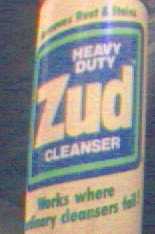
Can of Zud (6K)
While browsing the grocery store shelves I noticed a small, brightly colored 6oz. can of Zud™. The back label listed, among other things, that this product "cleans STAINLESS STEEL SINKS." The price was only $1.19 US so I decided to give it a try. It worked! This abrasive cleaner was very much like Comet except for a special ingredient, Oxalic Acid. I was more than just a little bit intrigued so I fired up the old web browser and searched for information about this substance. The Material Safety Data Sheet made it seem like a dangerous chemical but then again, the MSDS for water probably looks pretty scary also. The MSDS contained a curious fact: Oxalic acid decomposes at its melting point of 101°C producing Carbon Dioxide and Carbon Monoxide! I put a small amount in a hot frying pan. It smoked a little bit but nothing much happened. There must be only a small amount of Oxalic Acid in Zud.
I would like to publicly apologize to the manufacturer for what happened next. The remaining contents of the can of Zud were dumped into a bowl and mixed with distilled water. After a few hours, most of the heavy abrasive particles collected on the bottom. The water, now a cloudy yellow color was decanted off and filtered. A coffee filter was good enough to remove the larger particles but the smaller ones passed right through. Qualitative filter paper was tried, with better results, but it was taking to long so I opted for another couple of hours to let the remaining particles settle out. The yellowish water was decanted again but this time appeared to be mostly free of particles.

Products of Zud Extraction (5K)
The water was evaporated on a hot water bath (double boiler) leaving a bit of chunky, yet sticky residue. The residue was scraped out of the evaporating device and placed in a jar of Acetone from the hardware store. The mixture was briskly stirred into solution but, upon standing, a gummy yellow substance collected on the bottom. The gummy yellow putty was collected and set aside. After a few minutes it seemed to take on a greenish color. The acetone wash was then returned to the double boiler and evaporated leaving a nice crop of white to light brown crystals. These crystals were subjected to the same frying-pan treatment as above and they sublimated leaving very little residue.
Swingin' For the Fence (and Striking Out)
After the apparent success with most of one can of Zud, I decided to try a somewhat larger scale extraction. I went to the store with the intention of buying four 6oz cans of Zud but instead saved almost $2US by buying two 12oz cans of Bar Keeper's Friend instead. This product was on the shelve next to the Zud and the label says that it also contains Oxalic Acid, so what the hell.
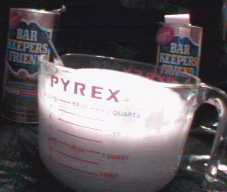
Cans of Bar Keeper's Friend (6K)
Two cans of Bar Keeper's Friend cleanser were mixed with distilled water in a larger measuring cup. Within minutes a heavy precipitate settled to the bottom. After 30 minutes the powder formed a tight pack on the bottom of the cup so the liquid was decanted off. The wet precipitate looked like most of the volume of the original powder considering that it was soaking wet. It was thrown away. Filtering the liquid with coffee filters proved to be relatively useless. After two hours another thick layer of precipitate formed. Careful examination showed two layers, the top layer was brighter white and composed of smaller particles. The liquid was again decanted and the wet powder scraped into the trash.
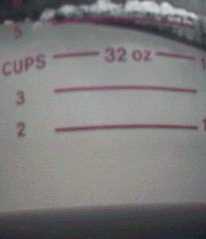
After two days (4K)
After two days the liquid was much clearer and another layer of bright white wet powder was on the bottom. The liquid was again carefully decanted and the powder thrown away. Also, a thin ring of crunchy crystals formed around the water line.
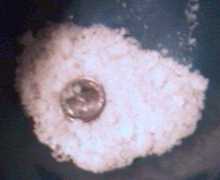
First extraction product (4K)
The liquid volume was concentrated on a hot water bath. It was allowed to cool after about 80% of the volume had been removed. A thick solid layer of crunchy crystals formed on top of the container reminiscent of a muddy puddle that has just begun to freeze over. These crystals were collected, pulverized, and washed with Acetone. The Acetone turned quite brown but the crystals became bright white. The Acetone was added to the mother liquid. Dissolving the crystals in water was somewhat more difficult than expected but produced a lot of soapy foam.

Second extraction product (6K)
The remaining liquid was again concentrated on a hot water bath. When the last of the Acetone and water evaporated, the hot water bath became a boiling water bath. I was playing a computer game and did not notice until I began to cough unexplainably. Apparently the Oxalic Acid had begun to decompose into Carbon Dioxide and Carbon Monoxide (!). The dish was promptly removed from the heat and some cursing was in order... The residue seemed to solidify as it cooled and dried. It was quite brown. Strange because the starting material was very white. Suspect decomposition. The residue was pulverized, dissolved in acetone, and allowed to settle for 15 minutes. A small amount of un-dissolved solids were removed and dissolved in water. The water was evaporated yielding the sticky green semi-solid seen at left. The original picture was more brown than it should have been so the green was enhanced to approximate the actual color. This substance was somewhat foamy when washed down the drain.
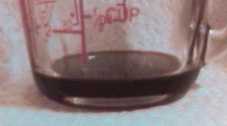
Nasty brown liquid (4K)
The acetone was again removed on the hot water bath. The residue looked much like it did before which is no big surprise considering that only the small amount of green spooge from above was not soluble in the Acetone the first time. The residue was then washed with methylene chloride. The wash liquid was very dark but a good crop of nice crystals remained un-dissolved. The methylene chloride was separated from the solids and removed on the hot water bath. A nasty dark brown liquid remained. It was also more difficult to dissolve in water than I expected. It smelled like charred rubble and foamed like detergent when washed down the drain.
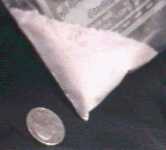
Suspected Active Ingredient (3K)
This is the remaining powder after the dark brown liquid was removed. A nice amount of it was collected but much less than expected relative to the Zud. This must be the Oxalic acid. There is one way to tell for certain....
A small bit of the powder was put on this spoon. The spoon was put directly onto a hot stove where it quickly lost most of its volume as a gas that tickled the back of the throat triggering a cough reflex. A small amount of carbonized crap remained.
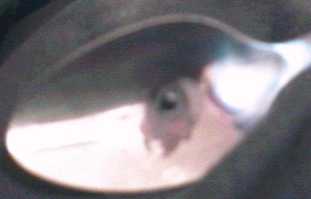
Results of heating (5K)
Half Assed Amateur Analysis
In my very uneducated and non-scientific opinion, either Zud contains a lot more Oxalic Acid than Bar Keeper's Friend or a lot more of it was lost during extraction. I was actually much more careful with the Bar Keeper's Friend extraction so the only likely step for loosing the Acid would have been through decomposition during the concentration process. Even if they contain the same amount of active ingredient the extraction from Zud was much easier because Zud's larger abrasive particles are easier to remove. There are also fewer other ingredients to separate. It should be pointed out that I have no idea as to the possibility of interactions between Oxalic Acid and either Acetone or Methylene Chloride so I can not be certain of these results.
Product Warning Labels
Zud:
WARNING: Contains oxalic acid. KEEP OUT OF REACH OF CHILDREN. In case of eye contact, flush immediately with water 10-15 minutes. Do not use or mix with chlorine type bleaches or other household chemicals as harmful fumes may result.
FIRST AID - INTERNAL: If swallowed, rinse mouth and give one or two glasses of milk or water.
DO NOT induce vomiting. Call physician immediately. For Medical Emergency call 800-338-6167
Bar Keeper's Friend:
Do not mix with other household chemicals, including detergents or bleach.
Questions? Comments? Call toll-free 1-800-433-5818.